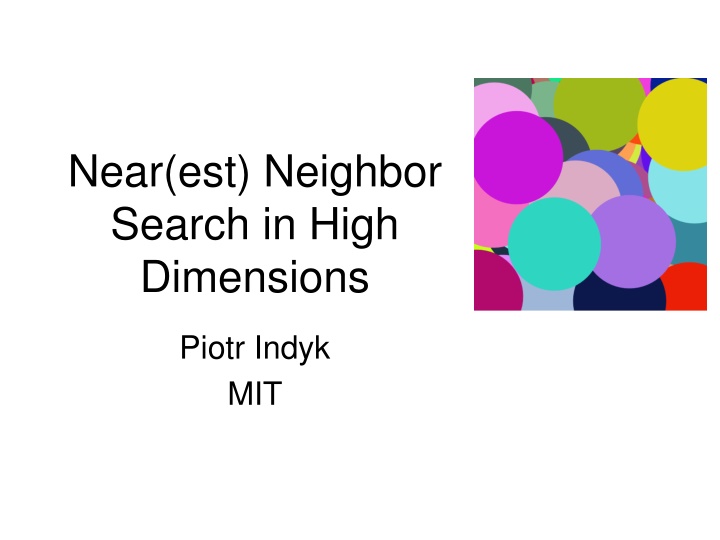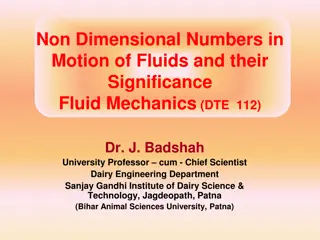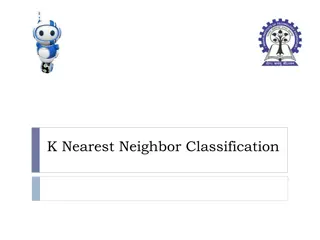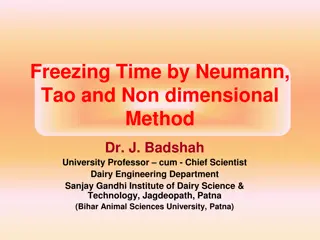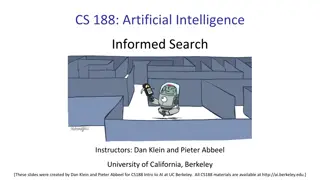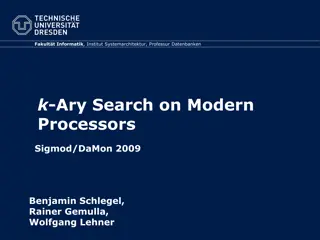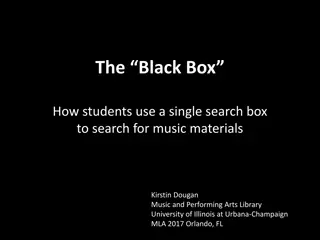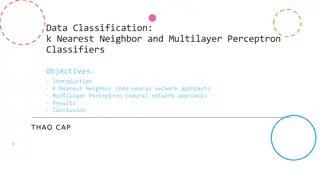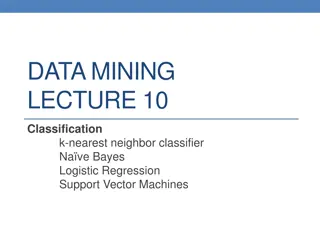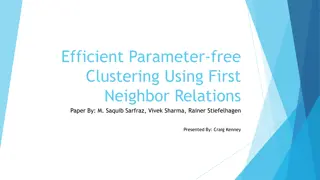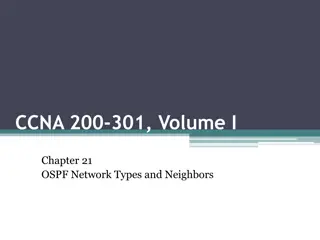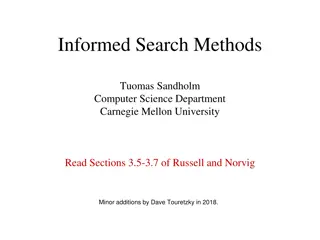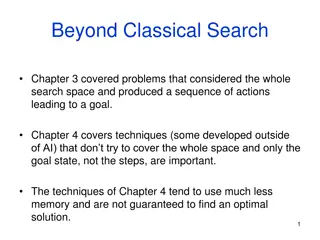High-Dimensional Neighbor Search: Applications in Machine Learning
Explore the realm of high-dimensional neighbor search techniques, featuring applications in machine learning such as the nearest neighbor rule and near-duplicate retrieval. Understand concepts like Voronoi diagrams, approximate nearest neighbor algorithms, and more. Delve into the complexities and efficiencies of solving nearest neighbor queries in high-dimensional spaces, uncovering the limitations and general solutions available. Discover how algorithms like Kd-trees, Cover Trees, and LSH play critical roles in handling high-dimensional data effectively.
Download Presentation

Please find below an Image/Link to download the presentation.
The content on the website is provided AS IS for your information and personal use only. It may not be sold, licensed, or shared on other websites without obtaining consent from the author.If you encounter any issues during the download, it is possible that the publisher has removed the file from their server.
You are allowed to download the files provided on this website for personal or commercial use, subject to the condition that they are used lawfully. All files are the property of their respective owners.
The content on the website is provided AS IS for your information and personal use only. It may not be sold, licensed, or shared on other websites without obtaining consent from the author.
E N D
Presentation Transcript
Near(est) Neighbor Search in High Dimensions Piotr Indyk MIT
Nearest Neighbor Search Given: a set P of n points in Rd Nearest Neighbor: for any query q, returns a point p P minimizing ||p-q|| r-Near Neighbor: for any query q, returns a point p P s.t. ||p-q|| r (if it exists) r q
High-dimensional near(est) neighbor: applications Machine learning: nearest neighbor rule Find the closest example with known class Copy the class label Near-duplicate Retrieval ? Dimension=number of pixels (... , 1, , 4, , 2 , , 2, ) To be or not to be (... , 6, , 1, , 3 , , 6, ) (... , 1, , 3, , 7 , , 5, ) (... , 2, , 2, , 1 , , 1, ) Dimension=number of words
The case of d=2 Compute Voronoi diagram Given q, perform point location Performance: Space: O(n) Query time: O(log n)
The case of d>2 Voronoi diagram has size n[d/2] [Dobkin-Lipton 78,Meiser 93,Clarkson 88]: nO(d) space, (d+ log n)O(1) time We can also perform a linear scan: O(dn) space and time Can speedup the scan by roughly O(n1/d) These are pretty much the only known general solutions ! Kd-trees, Cover Trees, LSH, Spill trees, etc all denegerate to one of the two extremes in the worst case In fact: If there was an algorithm that performs n queries in O(dn1+ )time for <1 (incl. preprocessing) Then there would be an algorithm solving satisfiability in (slightly) sub-exponential time [Williams 04]
Approximate Nearest Neighbor c-Approximate Nearest Neighbor: build data structure which, for any query q returns p P, ||p-q|| cr, where r is the distance to the nearest neighbor of q r q cr
Approximate Near Neighbor c-Approximate r-Near Neighbor: build data structure which, for any query q: If there is a point p P, ||p-q|| r it returns p P, ||p-q|| cr r Most algorithms randomized: For each query q, the probability (over the randomness used to construct the data structure) is at least 90% q cr
Approximate algorithms Space/time exponential in d [Arya-Mount 93],[Clarkson 94], [Arya- Mount-Netanyahu-Silverman-Wu 98] [Kleinberg 97], [Har-Peled 02], . Space/time polynomial in d[Indyk-Motwani 98], [Kushilevitz- Ostrovsky-Rabani 98], [Indyk 98], [Gionis-Indyk-Motwani 99], [Charikar 02], [Datar- Immorlica-Indyk-Mirrokni 04], [Chakrabarti-Regev 04], [Panigrahy 06], [Ailon- Chazelle 06], [Andoni-Indyk 06], ., [Andoni-Indyk-Nguyen-Razenshteyn 14], [Andoni- Razenshteyn 15] Space dn+nO(1/ 2) Time Comment Norm Ref d * logn / 2 (or 1) c=1+ Hamm, l2 [KOR 98, IM 98] n (1/ 2) O(1) [AIP 06] dn+n1+ (c) dn (c) (c)=1/c Hamm, l2 l2 l2 l2 l2 l2 l2 [IM 98], [GIM 98],[Cha 02] (c)<1/c [DIIM 04] (c)=1/c2 + o(1) [AI 06] (c)= (7/8)/c2 + o(1/c3) [AINR 14] (c)= 1/(2c2-1)+o(1) [AR 15] dn * logs dn (c) (c)=O(1/c) [Panigrahy 06] (c)=O(1/c2) [AI 06]
Approximate Near Neighbor Algorithms In this talk we focus on: Euclidean norm Polynomial dependence on dimension Near-linear space: dn+n1+ (c) , (c)<1 Sub-linear query time: dn (c) (2) 0.5 0.45 0.25 0.14 1998 2004 2006 2014 2015 Year
LSH A family H of functions h: Rd U is called (P1,P2,r,cr)-sensitive for distance D, if for any p,q: If D(p,q) <r then Pr[ h(p)=h(q) ] > P1 If D(p,q) >cr then Pr[ h(p)=h(q) ] < P2 Example: Hamming distance h(p)=pi, i.e., the i-th bit of p Probabilities: Pr[ h(p)=h(q) ] = 1-D(p,q)/d p=10010010 q=11010110
Algorithm We use functions of the form g(p)=<h1(p),h2(p), ,hk(p)> Preprocessing: Select g1 gL independently at random For all p P, hash p to buckets g1(p) gL(p) Query: Retrieve the points from buckets g1(q), g2(q), , until Either the points from all L buckets have been retrieved, or Total number of points retrieved exceeds 3L Answer the query based on the retrieved points Total time: O(dL)
Analysis Lemma1: the algorithm solves c-approximate NN with: Number of hash functions: L=C n , =log(1/P1)/log(1/P2) (C=C(P1,P2) is a constant for P1 bounded away from 0) Constant success probability for a fixed query q Lemma 2: for Hamming LSH functions, we have =1/c
Proof Define: p: a point such that ||p-q|| r FAR(q)={ p P: ||p -q|| >c r } Bi(q)={ p P: gi(p )=gi(q) } Will show that both events occur with >0 probability: E1: gi(p)=gi(q) for some i=1 L E2: i |Bi(q) FAR(q)| < 3L
Proof ctd. Set k= ceil(log1/P2 n) For p FAR(q) , Pr[gi(p )=gi(q)] P2k 1/n E[ |Bi(q) FAR(q)| ] 1 E[ i |Bi(q) FAR(q)| ] L Pr[ i |Bi(q) FAR(q)| 3L ] 1/3
Proof, ctd. Pr[ gi(p)=gi(q) ] Pr[ gi(p) gi(q), i=1..L] (1-1/L)L 1/e 1/P1k P1 log1/P2 (n)+1 1/(P1 n )=1/L
Proof, end Pr[E1 not true]+Pr[E2 not true] 1/3+1/e =0.7012. Pr[ E1 E2 ] 1-(1/3+1/e) 0.3
Proof of Lemma 2 Statement: for P1=1-r/d P2=1-cr/d we have =log(P1)/log(P2) 1/c Proof: Need P1c P2 But (1-x)c (1-cx)for any 1>x>0, c>1
Recap LSH solves c-approximate NN with: Number of hash fun: L=O(n ), =log(1/P1)/log(1/P2) For Hamming distance we have =1/c Questions: Beyond Hamming distance ? Reduce the exponent ?
Random Projection LSH for L2 [Datar-Immorlica-Indyk-Mirrokni 04] Define hX,b(p)= (p*X+b)/w : w r X=(X1 Xd) , where Xi are i.i.d. random variables chosen from Gaussian distribution b is a scalar chosen uniformly at random from [0,w] p X w w
Analysis Need to: Compute Pr[h(p)=h(q)] as a function of ||p-q|| and w; this defines P1 and P2 For each c choose w that minimizes =log1/P2(1/P1) w w
(c) for l2 Improvement not dramatic But the hash function very simple and works directly in l2
Ball lattice hashing [Andoni-Indyk 06] Instead of projecting onto R1, project onto Rt , for constant t Intervals lattice of balls Can hit empty space, so hash until a ball is hit Analysis: =1/c2 + O( log t / t1/2 ) Time to hash is tO(t) Total query time: dn1/c2+o(1) [Motwani-Naor-Panigrahy 06]: LSH in l2 must have 0.45/c2 [O Donnell-Wu-Zhou 09]: 1/c2 o(1) p X w w p
Data-dependent hashing [Andoni-Razenshteyn 15] The aforementioned LSH schemes are optimal for data oblivious hashing Select g1 gL independently at random For all p P, hash p to buckets g1(p) gL(p) Retrieve the points from buckets g1(q), g2(q), The new schemes are data dependent If the points are random , can prove better bound If the points are not random , cluster and recurse Improve exponent from 1/c2 to 1/(2c2-1)
LSH Zoo Have seen: Hamming metric: projecting on coordinates L2 :random projection+quantization Other (provable): L1 norm: random shifted grid [Andoni-Indyk 05] (cf. [Bern 93]) Vector angle [Charikar 02] based on [Goemans-Williamson 94] Jaccard coefficient [Broder 97] J(A,B) = |A B| / |A u B| Other (empirical): inscribed polytopes [Terasawa-Tanaka 07], orthogonal partition [Neylon 10] Other (applied): semantic hashing, spectral hashing, kernelized LSH, Laplacian co-hashing, , BoostSSC, WTA hashing,
Min-wise hashing [Broder 97, Broder-Charikar-Frieze- Mitzenmacher 98] In many applications, the vectors tend to be quite sparse (high dimension, very few 1 s) Easier to think about them as sets For two sets A,B, define the Jaccard coefficient: J(A,B)=|A B|/|A U B| If A=B then J(A,B)=1 If A,B disjoint then J(A,B)=0 Can we design LSH families for J(A,B) ?
Hashing Mapping: g(A)=mina A h(a) where h is a random permutation of the elements in the universe Fact: Pr[g(A)=g(B)]=J(A,B) Proof: Where is min( h(A) U h(B) ) ? A B
Random hyperplane [Goemans-Williamson 94, Charikar 02] Let u,v be unit vectors in Rm Angular distance: A(u,v)=angle between u and v Hashing: Choose a random unit vector r Define s(u)=sign(u*r)
Probabilities What is the probability of sign(u*r) sign(v*r) ? It is A(u,v)/ u A(x,y) v
New LSH scheme, ctd. How does it work in practice ? The time tO(t)dn1/c2+f(t) is not very practical Need t 30 to see some improvement Idea: a different decomposition of Rt Replace random balls by Voronoi diagram of a lattice For specific lattices, finding a cell containing a point can be very fast fast hashing
Leech Lattice LSH Use Leech lattice in R24 , t=24 Largest kissing number in 24D: 196560 Conjectured largest packing density in 24D 24 is 42 in reverse Very fast (bounded) decoder: about 519 operations [Amrani-Beery 94] Performance of that decoder for c=2: 1/c2 1/c Leech LSH, any dimension: Leech LSH, 24D (no projection): 0.25 0.50 0.36 0.26
